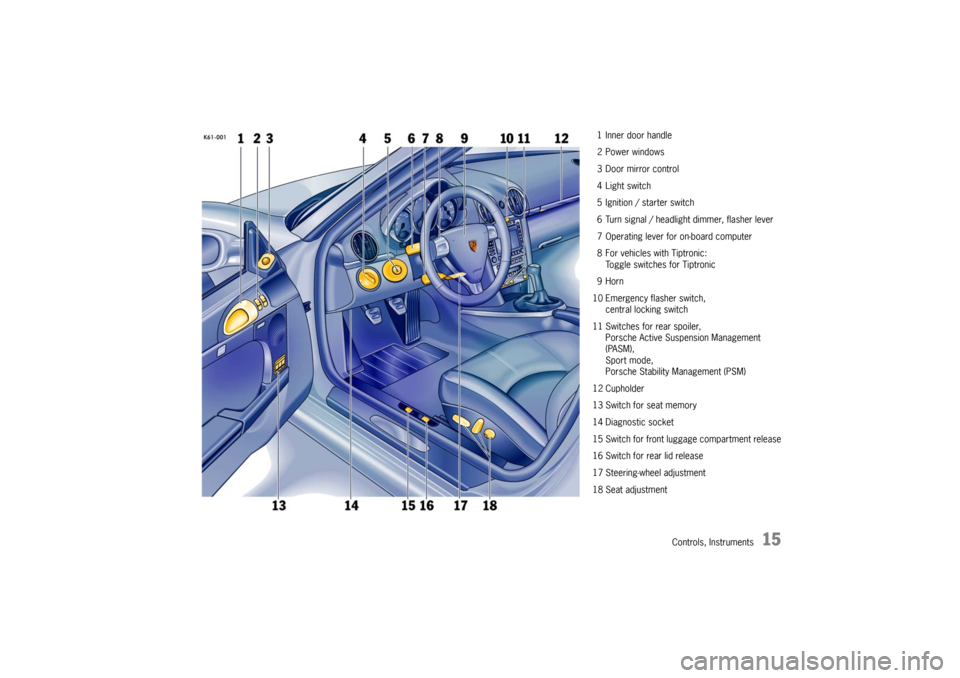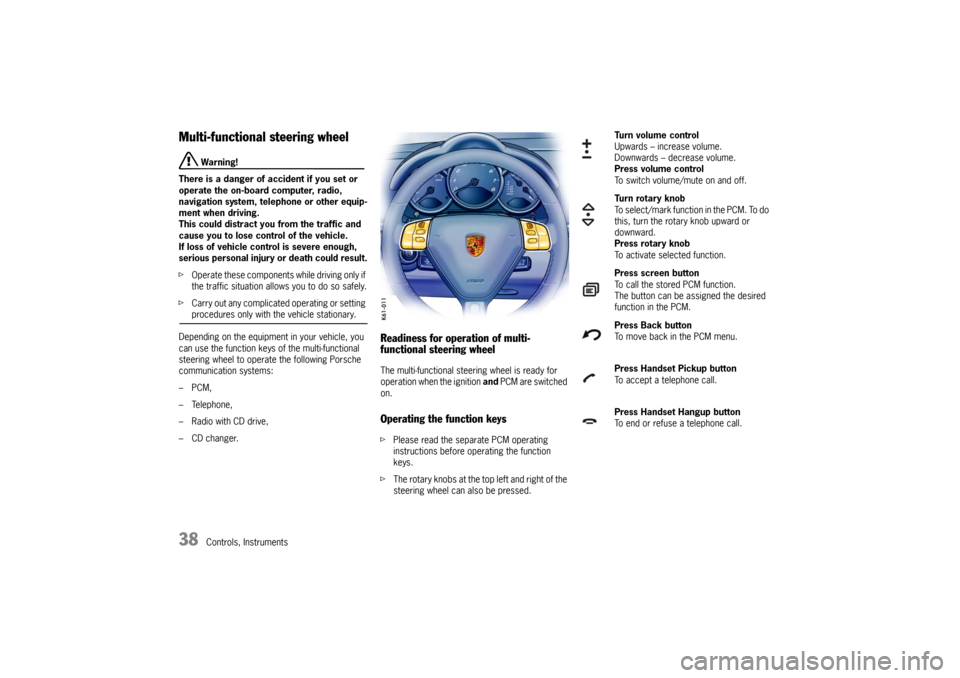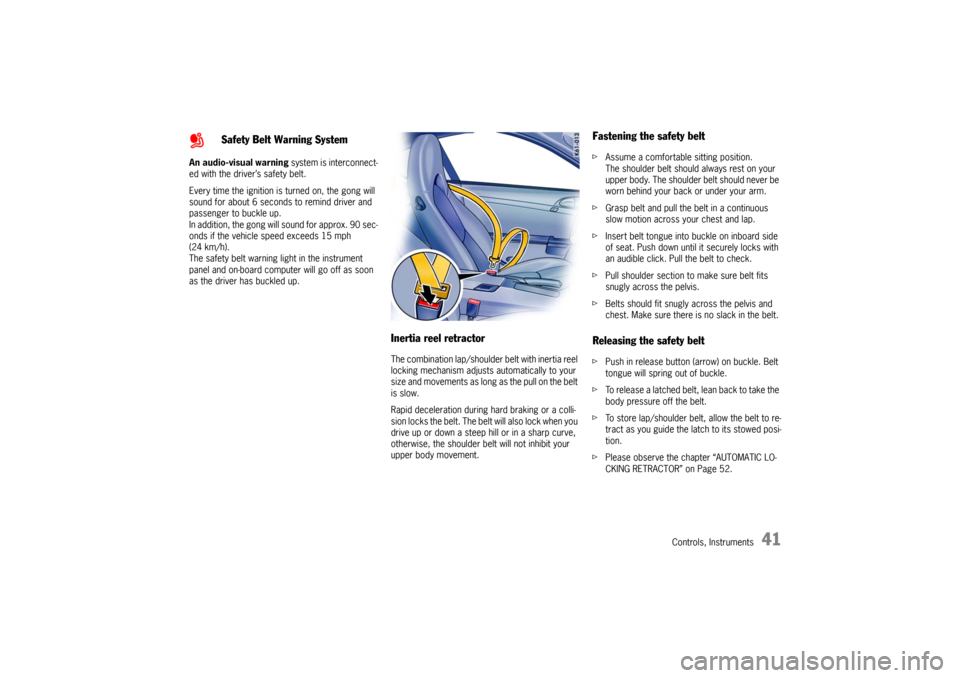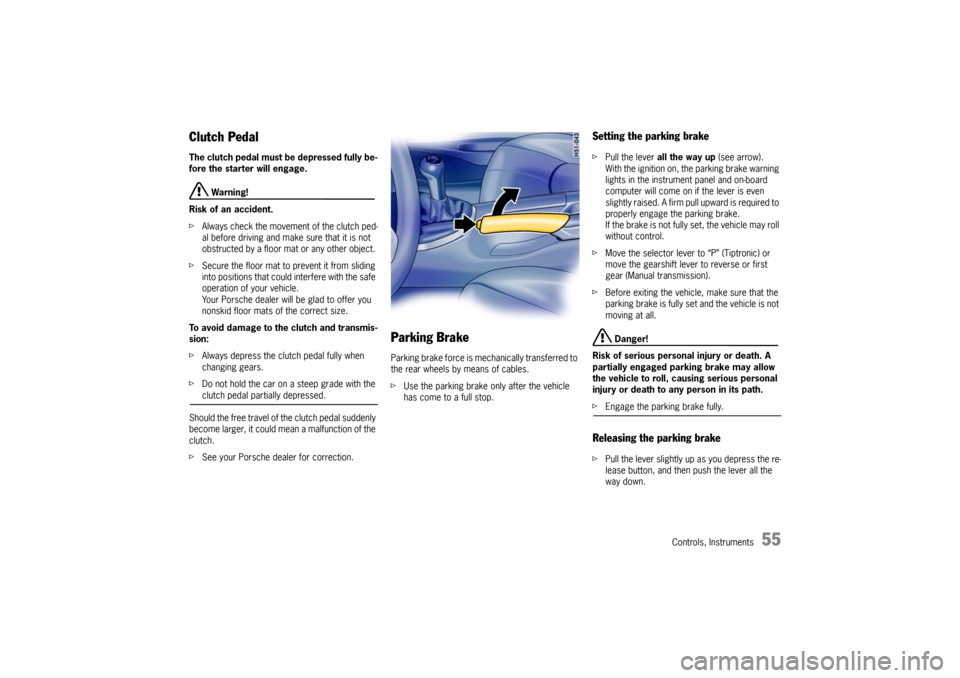computer PORSCHE CAYMAN 2006 1.G Owners Manual
[x] Cancel search | Manufacturer: PORSCHE, Model Year: 2006, Model line: CAYMAN, Model: PORSCHE CAYMAN 2006 1.GPages: 280, PDF Size: 4.89 MB
Page 7 of 280

7
Environmentally friendly vehicles Modern environmental technology ensures compli-
ance with all emission laws applicable worldwide.
It has the following advantages:
– Rapid operational readiness of the catalytic
converters ensures low emissions, even in
short-trip operation.
– Reliable operation and good emission control
over a long useful life.
– Please observe the chapter “FUEL ECONOMY”
on Page 184.
Recycling – for a Porsche, this is virtually
an academic question More than two-thirds of all Porsches ever built are
still running.
Just in case recycling is ever necessary, we
take the following precautionary measures:
– Identification of all materials.
– Use of recyclable materials.
– Reusable components designed for simple
removal.
– These reasons result in a further increase in
the recycling rate which is currently 80 per
cent.
Emission control is built in Innovative engine technology combines high en-
gine performance and environmental compatibili-
ty.
The engine diagnosis system electronically moni-
tors the components and systems that affect ex-
haust gases.
This continuous monitoring and fault storage ena-
bles swift, reliable diagnosis and fault detection.
Any fault messages are indicated to the driver by
the “Check Engine” warning light and the on-board
computer.
fPlease observe the chapter “WARNINGS ON
THE INSTRUMENT PANEL AND THE ON-
BOARD COMPUTER” on Page 114.
Page 8 of 280

8Porsche Ceramic Composite Brake
(PCCB)The high-performance brake system is designed
for optimal braking effect at all speeds and tem-
peratures.
Certain speeds, braking forces and ambient
conditions (such as temperature and humidity)
therefore might cause brake noises.
Wear on the different components and braking
system, such as brake pads and brake discs, de-
pends to a great extent on the individual driving
style and the conditions of use and therefore can-
not be expressed in actual miles on the road.
The values communicated by Porsche are based
on normal operation adapted to traffic. Wear in-
creases considerably when the vehicle is driven on
race tracks or through an aggressive driving style.
fPlease consult an authorized Porsche dealer
about the current guidelines in effect before
such use of your vehicle.
Setting and operation vehicle
components when driving
Warning!
There is a danger of an accident if you oper-
ate or set the on-board computer, radio, nav-
igation system, telephone or other equip-
ment while driving.
This could distract you from the traffic and
cause you to lose control of the vehicle re-
sulting in serious personal injury or death.
fOperate the equipment while driving only if the
traffic situation allows you to do so safely.
fCarry out any complicated operating or setting procedures only with the vehicle stationary.
Portable Fuel Containers
Danger!
Portable fuel containers may leak, whether
they are full or partially empty. Fuel leaking
from a portable container carried in your ve-
hicle could, in case of an accident, cause a
fire or explosion, resulting in serious perso-
nal injury or death.
fNever carry additional fuel in portable contain-ers in your vehicle.
Engine Exhaust
Danger!
Engine exhaust is dangerous if inhaled.
Engine exhaust fumes have many compo-
nents which you can smell. They also contain
carbon monoxide (CO), which is a colorless
and odorless gas.
Carbon monoxide can cause unconscious-
ness and even death if inhaled.
fNever start or let the engine run in an en-
closed, unventilated area.
It is not recommended to sit in your car for pro-
longed periods with the engine on and the car not moving.
Ground ClearancePlease bear in mind the limited clearance of your
car on uneven surfaces, when parking (curbs), on
ramps, lifting platforms, etc.
Page 11 of 280

Controls, Instruments
11 Controls, Instruments
Before driving off... ...................................... 12
Break in hints for the first
2,000 miles/3,000 kilometers ...................... 14
Keys ........................................................... 17
Security Wheel Bolts .................................... 17
Doors ......................................................... 23
Alarm System,
Passenger Compartment Monitoring ............. 24
Power Windows ........................................... 26
Inside mirror ................................................ 28
Automatic Anti-Glare
Interior Mirror and Door Mirrors .................... 28
Door Mirrors ................................................ 29
Seat Adjustment .......................................... 32
Seat Memory ............................................... 34
Heated Seats .............................................. 36
Steering Wheel Adjustment ........................... 37
Multi-functional steering wheel ....................... 38
Sun Visors ................................................... 39
Safety Belts ................................................. 40
Airbag Systems ........................................... 42
Child Restraint Systems ................................ 49
LATCH System
Child seat bracket on the passenger’s seat .... 53
Child Restraint Anchorage ............................ 54
Clutch Pedal ................................................ 55
Parking Brake .............................................. 55
Brakes ........................................................ 56
ABS Brake System
(Antilock Brake System) ................................ 59
Sport Mode ................................................. 61
Porsche Stability Management (PSM) ............. 62Porsche Active Suspension Management
(PASM) ........................................................ 65
Retractable Rear Spoiler ............................... 66
Parking Aids ................................................ 68
Interior Lights .............................................. 70
Operation, Instruments ................................. 72
Ignition/Starter Switch with anti-theft Steering
Lock ........................................................... 74
Starting Procedures ..................................... 76
Stopping engine ........................................... 77
Instrument Panel USA Models ....................... 79
Automatic Speed Control Indicator light ......... 82
Instrument Illumination .................................. 82
Trip Odometer ............................................. 83
Speedometer .............................................. 84
Changing over between Miles / Kilometers .... 84
Tachometer ................................................. 85
Turn Signal Indicator Light ............................. 85
High Beam .................................................. 85
Cooling System ........................................... 86
Tiptronic ...................................................... 87
Fuel ............................................................ 88
Clock .......................................................... 89
Outside temperature .................................... 89
Check Engine Warning Light .......................... 90
Central warning light .................................... 91
Brake warning light USA ............................... 91
Brake warning light Canada .......................... 91
On-Board Computer (BC) .............................. 92
Light Switch .............................................. 122
Welcome Home Lighting ............................. 123
Automatic Headlight Beam Adjustment ........ 123Turn Signal/ Headlight Dimmer/Parking light /
Flasher Lever ............................................. 124
Windshield Wiper / Washer Lever ................ 125
Automatic Speed Control ............................ 128
Air conditioning .......................................... 130
Automatic air conditioning system ...............133
Central and side vents ................................ 136
Fresh-air intake .......................................... 136
Emergency Flasher Switch .......................... 137
Ashtray ..................................................... 138
Cigarette Lighter ........................................139
Sockets .................................................... 140
Storage in the passenger compartment ....... 141
Cupholder
(holder for drinks cans and cups) ...............143
Fire extinguisher ........................................145
Trunk Entrapment ....................................... 146
Front Luggage Compartment lid .................. 147
Front Luggage Compartment ...................... 149
Rear Lid .................................................... 150
Rear Luggage Compartment ....................... 151
Porsche Communication Management
(PCM) ........................................................ 155
Car Audio Operation/Tips ........................... 156
HomeLink .................................................. 159
Roof Transport System ............................... 162
Page 15 of 280

Controls, Instruments
15
1 Inner door handle
2 Power windows
3 Door mirror control
4 Light switch
5 Ignition / starter switch
6 Turn signal / headlight dimmer, flasher lever
7 Operating lever for on-board computer
8 For vehicles with Tiptronic:
Toggle switches for Tiptronic
9Horn
10 Emergency flasher switch,
central locking switch
11 Switches for rear spoiler,
Porsche Active Suspension Management
(PASM),
Sport mode,
Porsche Stability Management (PSM)
12 Cupholder
13 Switch for seat memory
14 Diagnostic socket
15 Switch for front luggage compartment release
16 Switch for rear lid release
17 Steering-wheel adjustment
18 Seat adjustment
Page 38 of 280

38
Controls, Instruments
Multi-functional steering wheel
Warning!
There is a danger of accident if you set or
operate the on-board computer, radio,
navigation system, telephone or other equip-
ment when driving.
This could distract you from the traffic and
cause you to lose control of the vehicle.
If loss of vehicle control is severe enough,
serious personal injury or death could result.
fOperate these components while driving only if
the traffic situation allows you to do so safely.
fCarry out any complicated operating or setting procedures only with the vehicle stationary.
Depending on the equipment in your vehicle, you
can use the function keys of the multi-functional
steering wheel to operate the following Porsche
communication systems:
–PCM,
– Telephone,
– Radio with CD drive,
–CD changer.
Readiness for operation of multi-
functional steering wheelThe multi-functional steering wheel is ready for
operation when the ignition and PCM are switched
on.Operating the function keysfPlease read the separate PCM operating
instructions before operating the function
keys.
fThe rotary knobs at the top left and right of the
steering wheel can also be pressed.
Turn volume control
Upwards – increase volume.
Downwards – decrease volume.
Press volume control
To switch volume/mute on and off.
Turn rotary knob
To select/mark function in the PCM. To do
this, turn the rotary knob upward or
downward.
Press rotary knob
To activate selected function.
Press screen button
To call the stored PCM function.
The button can be assigned the desired
function in the PCM.
Press Back button
To move back in the PCM menu.
Press Handset Pickup button
To accept a telephone call.
Press Handset Hangup button
To end or refuse a telephone call.
Page 41 of 280

Controls, Instruments
41
An audio-visual warning system is interconnect-
ed with the driver’s safety belt.
Every time the ignition is turned on, the gong will
sound for about 6 seconds to remind driver and
passenger to buckle up.
In addition, the gong will sound for approx. 90 sec-
onds if the vehicle speed exceeds 15 mph
(24 km/h).
The safety belt warning light in the instrument
panel and on-board computer will go off as soon
as the driver has buckled up.
Inertia reel retractor The combination lap/shoulder belt with inertia reel
locking mechanism adjusts automatically to your
size and movements as long as the pull on the belt
is slow.
Rapid deceleration during hard braking or a colli-
sion locks the belt. The belt will also lock when you
drive up or down a steep hill or in a sharp curve,
otherwise, the shoulder belt will not inhibit your
upper body movement.
Fastening the safety beltfAssume a comfortable sitting position.
The shoulder belt should always rest on your
upper body. The shoulder belt should never be
worn behind your back or under your arm.
fGrasp belt and pull the belt in a continuous
slow motion across your chest and lap.
fInsert belt tongue into buckle on inboard side
of seat. Push down until it securely locks with
an audible click. Pull the belt to check.
fPull shoulder section to make sure belt fits
snugly across the pelvis.
fBelts should fit snugly across the pelvis and
chest. Make sure there is no slack in the belt. Releasing the safety beltfPush in release button (arrow) on buckle. Belt
tongue will spring out of buckle.
fTo release a latched belt, lean back to take the
body pressure off the belt.
fTo store lap/shoulder belt, allow the belt to re-
tract as you guide the latch to its stowed posi-
tion.
fPlease observe the chapter “AUTOMATIC LO-
CKING RETRACTOR” on Page 52.
Safety Belt Warning System
Page 45 of 280

Controls, Instruments
45
Seat adjustment for the passenger's seat
If the seat is in an extreme position (e.g., the back-
rest is in contact with the engine compartment
wall), the backrest can warp. Warping of the back-
rest can lead to malfunctions.
fCorrect the seat adjustment.
Ensure that the seat is not jammed and is self-
supporting.
Ensure that the backrest is in the upright posi-
tion.
fDo not transport a load and objects behind and
under the passenger's seat.
If the load or objects are under the seat, it can
cause malfunctions.
If the weight on the passenger's seat is reduced
significantly, e.g., by supporting weight on the
armrest, the passenger's airbag can be switched
off.
fSelect an upright seat position, and do not sup-
port weight on the armrests or lean out of the
window.
Always keep feet in the footwell while driving.
Do not put feet on the dashboard or the seat
area. Do not lean against the inside of the door
or outside the window while the vehicle is mov-
ing.
If the passenger's seat is warped significantly, a
message is displayed on the on-board computer:
fCorrect the seat adjustment.fPlease observe the chapter “WARNINGS ON
THE INSTRUMENT PANEL AND THE ON-
BOARD COMPUTER” on Page 114.
Page 47 of 280

Controls, Instruments
47
PASSENGER AIRBAG OFF indicator lamp
does not light up
– The passenger's airbag is active and ready for
operation.
– If the passenger's seat is not occupied, the
PASSENGER AIRBAG OFF indicator lamp will
also not light up, even though the passenger's
airbag is switched off.
Danger!
Risk of serious personal injury or death due
to the passenger airbag triggering uninten-
tionally.
When the ignition is on and the up to one-
year old child is seated in the child restraint
system on the passenger’s seat, the indicator
lamp „PASSENGER AIRBAG OFF“ must be on.
If the “PASSENGER AIRBAG OFF” indicator
lamp does not light up, it could indicate a
fault in the system.
In this case:
fOn vehicles with key-operated airbag deactiva-
tion device: Switch to position OFF.
fOn vehicles without key-operated airbag deac-
tivation device: Do not drive.
fHave the fault remedied at your nearest author-ized Porsche dealer.Note
The key switch for switching off the passenger’s
airbag in combination with the LATCH attachment
bracket are not installed at the factory. They can
be retrofitted.
fPlease see your authorized Porsche dealer.
Faults are indicated by a warning light in the instru-
ment panel and a message on the on-board com-
puter.
fPlease observe the chapter “WARNINGS ON
THE INSTRUMENT PANEL AND THE ON-
BOARD COMPUTER” on Page 114.
fIn the following cases you should immedi-
ately consult an authorized Porsche
dealer in order to assure the airbag sys-
tem is functioning properly:
– If the warning light does not light up when the
ignition key is inserted or
– If the warning light does not go out once the
engine is running or
– If the warning light appears while driving.
Airbag maintenanceIn order to ensure long-term functioning, the air-
bag system must be inspected by an authorized
Porsche dealer at the intervals recommended in
your Maintenance Booklet.
Important information
If you sell your Porsche, notify the purchaser that
the vehicle is equipped with airbags, and refer
them to the chapter, “Airbag Systems“, in the
Owner's Manual (safety and disposal rules).
Further information on the airbag system can be
found on stickers attached to the sun visors.
For special recommendations on the use of child
restraints:
fPlease observe the chapter “CHILD RES-
TRAINT SYSTEMS” on Page 49.
Warning light and warning
message
Page 55 of 280

Controls, Instruments
55
Clutch Pedal The clutch pedal must be depressed fully be-
fore the starter will engage.
Warning!
Risk of an accident.
fAlways check the movement of the clutch ped-
al before driving and make sure that it is not
obstructed by a floor mat or any other object.
fSecure the floor mat to prevent it from sliding
into positions that could interfere with the safe
operation of your vehicle.
Your Porsche dealer will be glad to offer you
nonskid floor mats of the correct size.
To avoid damage to the clutch and transmis-
sion:
fAlways depress the clutch pedal fully when
changing gears.
fDo not hold the car on a steep grade with the clutch pedal partially depressed.
Should the free travel of the clutch pedal suddenly
become larger, it could mean a malfunction of the
clutch.
fSee your Porsche dealer for correction.
Parking Brake Parking brake force is mechanically transferred to
the rear wheels by means of cables.
fUse the parking brake only after the vehicle
has come to a full stop.
Setting the parking brake fPull the lever all the way up (see arrow).
With the ignition on, the parking brake warning
lights in the instrument panel and on-board
computer will come on if the lever is even
slightly raised. A firm pull upward is required to
properly engage the parking brake.
If the brake is not fully set, the vehicle may roll
without control.
fMove the selector lever to “P” (Tiptronic) or
move the gearshift lever to reverse or first
gear (Manual transmission).
fBefore exiting the vehicle, make sure that the
parking brake is fully set and the vehicle is not
moving at all.
Danger!
Risk of serious personal injury or death. A
partially engaged parking brake may allow
the vehicle to roll, causing serious personal
injury or death to any person in its path.
fEngage the parking brake fully.Releasing the parking brake fPull the lever slightly up as you depress the re-
lease button, and then push the lever all the
way down.
Page 57 of 280

Controls, Instruments
57
If the warning lights in the instrument panel and on-
board computer go on while driving, the brake flu-
id level may be too low, or (if the brake pedal travel
has increased) one of the two brake circuits may
have failed.
A greater braking pressure will be required, stop-
ping distances will be longer and the braking be-
havior will change, particularly in curves.
With correctly adjusted brakes, and a correctly
working brake system, the pedal travel to the
point of brake actuation should be 1-3/16" to
1-9/16" or 30 to 40 mm.
Whenever the brake pedal travel exceeds this dis-
tance, have the brake system checked.
Brake pedal
Warning!
Risk of an accident.
Any obstruction of the pedal could increase
the stopping distance.
fAlways check the movement of the brake pedal
before driving and make sure that it is not ob-
structed by a floor mat or any other object.
fSecure the floor mat to prevent it from sliding
into positions that could interfere with the safe
operation of your vehicle.
Your Porsche dealer will be glad to offer you
floor mats of the correct size including a secur-ing possibility.
Note
In case one of the two brake circuits fails, in-
creased pedal travel is required to bring your vehi-
cle to a full stop.
Warning!
To avoid overheating and premature wear of
the brakes:
fBefore descending a steep grade, reduce
speed and shift the transmission into a lower
gear or driving position to control speed.
fDo not ride the “brakes” by resting your foot on
the pedal when not intending to apply brake
pressure.
fDo not hold the pedal down too long or too of-
ten.
This could cause the brakes to get hot and not function properly.
Brake warning light USA
Brake warning light
Canada